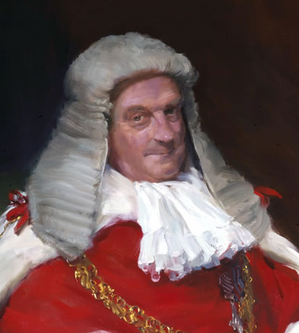In jurisprudence, double jeopardy is a procedural defence that prevents an accused person from being tried again on the same charges following an acquittal or conviction and in rare cases prosecutorial and/or judge misconduct in the same jurisdiction. Double jeopardy is a common concept in criminal law. In civil law, a similar concept is that of res judicata. Variation in common law countries is the peremptory plea, which may take the specific forms of autrefois acquit or autrefois convict. These doctrines appear to have originated in ancient Roman law, in the broader principle non bis in idem.

Derek William Bentley was a British man who was hanged for the murder of a policeman during a burglary attempt. Christopher Craig, then aged 16, a friend and accomplice of Bentley, was accused of the murder. Bentley was convicted as a party to the crime under the English law principle of "joint enterprise", as the burglary had been committed in mutual understanding and bringing deadly weapons. The outcome of the trial, and Home Secretary David Maxwell Fyfe's failure to grant clemency to Bentley, were highly controversial.
United States v. Dominguez Benitez, 542 U.S. 74 (2004), was a United States Supreme Court case in which the Court ruled that, in a criminal proceeding in federal court, a defendant who does not alert the district court to a possible violation of Rule 11 of the Federal Rules of Criminal Procedure must show on appeal that the violation affirmatively affected his rights in order to obtain reversal of his conviction by guilty plea. Rule 11, which pertains to criminal prosecutions in United States federal courts only, governs the offering of plea bargains to criminal defendants and the procedures district courts must employ to ensure that the defendant knows of and properly waives his trial-related constitutional rights.
Attempted murder is a crime of attempt in various jurisdictions.
Apprendi v. New Jersey, 530 U.S. 466 (2000), is a landmark United States Supreme Court decision with regard to aggravating factors in crimes. The Court ruled that the Sixth Amendment right to a jury trial, incorporated against the states through the Fourteenth Amendment, prohibited judges from enhancing criminal sentences beyond statutory maxima based on facts other than those decided by the jury beyond a reasonable doubt. The decision has been a cornerstone in the modern resurgence in jury trial rights. As Justice Scalia noted in his concurring opinion, the jury-trial right "has never been efficient; but it has always been free."

Reynolds v. United States, 98 U.S. 145 (1878), was a Supreme Court of the United States case that held that religious duty was not a defense to a criminal indictment. Reynolds was the first Supreme Court opinion to address the First Amendment's protection of religious liberties, impartial juries and the Confrontation Clauses of the Sixth Amendment.
Mandatory sentencing requires that offenders serve a predefined term for certain crimes, commonly serious and violent offenses. Judges are bound by law; these sentences are produced through the legislature, not the judicial system. They are instituted to expedite the sentencing process and limit the possibility of irregularity of outcomes due to judicial discretion. Mandatory sentences are typically given to people who are convicted of certain serious and/or violent crimes, and require a prison sentence. Mandatory sentencing laws vary across nations; they are more prevalent in common law jurisdictions because civil law jurisdictions usually prescribe minimum and maximum sentences for every type of crime in explicit laws.

Geoffrey Dawson Lane, Baron Lane, was a British Judge who served as Lord Chief Justice of England from 1980 to 1992. The later part of his term was marred by a succession of disputed convictions. Lane's critics claimed that his refusal to believe that police evidence could be institutionally corrupt, and his reluctance to overturn the verdict of a jury, "represented a dangerous hindrance to justice". His failure to allow the appeal of the Birmingham Six in 1988 led to calls for his resignation following their successful appeal in 1991; an editorial in The Times "urged him to go", while 140 members of parliament signed a House of Commons motion to that effect.

The Criminal Justice Act 2003 is an Act of the Parliament of the United Kingdom. It is a wide-ranging measure introduced to modernise many areas of the criminal justice system in England and Wales and, to a lesser extent, in Scotland and Northern Ireland. Large portions of the act were repealed and replaced by the Sentencing Act 2020.
The doctrine of common purpose, common design, joint enterprise, joint criminal enterprise or parasitic accessory liability is a common law legal doctrine that imputes criminal liability to the participants in a criminal enterprise for all reasonable results from that enterprise. The common purpose doctrine was established in English law, and later adopted in other common-law jurisdictions including Scotland, Ireland, Australia, Trinidad and Tobago, the Solomon Islands, Texas, Massachusetts, the International Criminal Court, and the International Criminal Tribunal for the former Yugoslavia.
Murder is an offence under the common law of England and Wales. It is considered the most serious form of homicide, in which one person kills another with the intention to cause either death or serious injury unlawfully. The element of intentionality was originally termed malice aforethought, although it required neither malice nor premeditation. Baker, chapter 14 states that many killings done with a high degree of subjective recklessness were treated as murder from the 12th century right through until the 1974 decision in DPP v Hyam.
In the English law of homicide, manslaughter is a less serious offence than murder, the differential being between levels of fault based on the mens rea or by reason of a partial defence. In England and Wales, a common practice is to prefer a charge of murder, with the judge or defence able to introduce manslaughter as an option. The jury then decides whether the defendant is guilty or not guilty of either murder or manslaughter. On conviction for manslaughter, sentencing is at the judge's discretion, whereas a sentence of life imprisonment is mandatory on conviction for murder. Manslaughter may be either voluntary or involuntary, depending on whether the accused has the required mens rea for murder.
State v. Mitchell, 170 Mo. 633, 71 S.W. 175 (1902), is a precedent-setting decision of the Supreme Court of Missouri which is part of the body of case law involving the prosecution of failed attempts to commit a crime. In United States law, cases involving failed criminal attempts can bring up interesting legal issues of whether the crime was unsuccessful due to factual impossibility or to legal impossibility.
The Double Jeopardy Clause of the Fifth Amendment to the United States Constitution provides: "[N]or shall any person be subject for the same offence to be twice put in jeopardy of life or limb..." The four essential protections included are prohibitions against, for the same offense:
Fraser v Her Majesty's Advocate (2011) UKSC 24 is a decision of the Supreme Court of the United Kingdom relating to the effect of non-disclosure of evidence to the defence at trial and the role of the Supreme Court of the United Kingdom in Scots criminal law.

The Hammersmith Ghost murder case of 1804 set a legal precedent in the UK regarding self-defence: that someone could be held liable for their actions even if they were the consequence of a mistaken belief.

The 2011 Helmand Province killing was the manslaughter of a wounded Taliban insurgent by Alexander Blackman, which occurred on 15 September 2011. Three Royal Marines, known during their trial as Marines A, B, and C, were anonymously tried by court martial. On 8 November 2013, Marines B and C were acquitted, but Blackman was initially found guilty of murder of the Afghan insurgent, in contravention of section 42 of the Armed Forces Act 2006. This made him the first British soldier to be convicted of a battlefield murder whilst serving abroad since the Second World War.
Sir Frederick Horace Lawton was a British barrister and judge who served as Lord Justice of Appeal from 1972 to 1986.

R v Jogee[2016] UKSC 8 was a 2016 judgment of the Supreme Court of the United Kingdom that reversed previous case law on joint enterprise. The Supreme Court delivered its ruling jointly with the Judicial Committee of the Privy Council, which was considering an appeal from Jamaica, Ruddock v The Queen [2016] UKPC 7.

Edward Francis Trevenen Brown KC is an English barrister who specialises in international criminal law and human rights. He is one of the most senior prosecutors at the Old Bailey where he also served as a Recorder, as well as sitting as a part-time circuit judge at Southwark Crown Court. Brown has written extensively on gang violence and joint enterprise murder in The Times.










